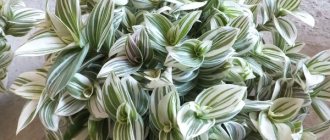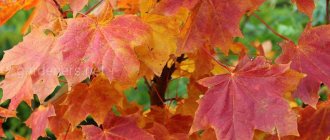Abutilon belongs to the Malvaceae family and is valued primarily for its beautiful and long flowering - some hybrid abutilons can bloom from spring to late autumn. There are more than 200 species of abutilones in nature (1), they are distributed mainly in the tropics, but one species, Abutilon theophrasti, is found in the southern regions of the European part of Russia - this is a malicious weed that most often settles in sugar beet fields.
Varieties and hybrids of various species are grown indoors, but there are also garden varieties of abutilon that can be grown as annuals (in warm regions and as perennials) in open ground.
Abutilon flowers are white, pink, red, yellow and orange, and there are varieties with contrastingly colored petal veins. There are variegated forms of abutilone with spotted and “marbled” leaves. The sizes of plants are also varied: depending on the variety, abutilon can be compact (20 - 25 cm) or tall, up to 70 cm tall (2).
Abutilone varieties
There are many varieties, but their range in stores is vanishingly small. Only breeders or collectors have a good selection of varietal plants, so it is better to purchase indoor maple from them.
Varieties of imported selection are common in Russia, but private breeders are successfully working to obtain domestic varieties. There are abutilon seeds on sale, but their range is also small - they are often offered in the form of mixtures of seeds of different varieties.
- Kirsch Orange. Miniature abutilon is about 25 cm high, the flowers are simple, five-petaled, light orange with pink veins, 4 - 6 cm in diameter. The leaves of young plants are ovoid, eventually becoming three-lobed.
- Roter Jewel. Medium-sized, up to 60 cm high. Flowers are bell-shaped, drooping, up to 10 cm in diameter. The color of the flowers is bright red, with a “satin” effect and darker veins. Young leaves are characterized by variegation; as they grow, they become green.
Roter Jewel. Photo: commons.wikimedia.org
Aureo-maculatum. Photo: pixabay.com
- Yellow Trumpet . A large bush with spreading shoots up to 70 cm long that can creep. The flowers are gramophone-shaped, bright yellow, drooping, up to 4 cm in diameter. Due to the long peduncles, the flowers look like hanging bells.
- Aureo -maculatum. A very unusual abutilon with pronounced “maple-shaped” leaves and strong variegation: the leaves are covered with a whitish pattern of spots and veins. The flowers are orange, bell-shaped, slightly drooping, solitary or in inflorescences of 2–3 pieces, up to 4 cm in diameter. Plant height is up to 50 cm.
Types of abutilone
Hybrid and decorative types of abutilon are grown at home. It is the variety of hybrid forms of indoor maple that makes it possible to admire plants of any size with a wide variety of leaf and flower colors.
The leaves of adult plants are quite large, up to 10 centimeters. They have a green, motley or spotted color.
The beautiful abutilon flowers, which look like Chinese lanterns or bells, will not leave anyone indifferent. Inflorescences on long stalks can be red, pink, orange, white, golden and other shades of the rainbow. Depending on the shape of the flower, terry and simple types of shrubs are distinguished. Flowering lasts from early spring to late autumn.
Psychologists believe that abutilone has a calming effect, helps relieve nervous tension and even relieve depression.
The most popular types of indoor maple.
Abutilon Juliet
Many gardeners love this type of indoor maple. After all, the plant is very unpretentious, does not require light, and grows quickly. Within a year, Abutilon Juliet grows up to half a meter in height. The plant pleases with its flowers, without ceasing, all year round. The flowers are bright, large, each about six centimeters in diameter. It begins to bloom six months after sowing the seeds.
Abutilon Amazonian
This species is also known as Abutilon megapotamus, or weeping Chinese lantern. Each flower of the plant is very similar to a lantern. It is yellow in color, has a crimson beginning and a fiery red corolla. In good habitat conditions, Abutilon megapotamii blooms almost constantly. The leaves are medium in size, oblong in shape with uneven teeth.
Abutilon Bella
A very compact and decorative plant, it is characterized by great branching and large bright flowers that practically fill the branches. Pink, white or gold flowers look spectacular against green foliage. Abutilon Bella does not grow higher than forty centimeters, it does not need pruning or pinching and blooms beautifully all year round. That's why all gardeners adore him. The bush will perfectly complement any interior design; bright flowers will fill the house with comfort and beauty. This species is similar to the Abutilon variety - Isabella, which is characterized by bright flowers of even larger size.
Abutilon Bellevue
This type of Abutilon is a hybrid, the Bellevue mixture forms a plant up to two meters in height, with timely pruning and proper care, it has the shape of a beautiful and lush bush. The flowers of the bush can be of all colors of the rainbow.
Abutilone Victorian lady
Also known as Abutilon terry. A medium-growing variety, the flowers are lush, double, and have a soft pink color.
Grape leaf abutilone
The leaves of the plant are similar to grape leaves, hence the name of the variety. They are green, velvety, have a small fluff underneath, the leaves are about fifteen centimeters long. Several flowers are collected in clusters and fall beautifully on long stems. The most common flowers are blue and lilac. Flowering occurs in May.
Caring for abutilone at home
The abutilon flower is not considered the most capricious to care for, but you need to know some of the subtleties of its cultivation. The main thing to consider if you decide to grow abutilon is its final size, since tall varieties can take up quite a lot of space not only due to the height of the bush, but also due to its width.
Lighting
Abutilon prefers bright light, but can be damaged by direct midday sun, so it should be positioned so that it receives several hours of sunlight in the morning or evening.
You can grow indoor maple in slight shade, but then the flowering may be less abundant. Variegated varieties of abutilon remain decorative only in constant bright light; in the shade, their leaves lose color.
In winter, when daylight hours are short, abutilon may require additional lighting with a phytolamp.
Temperature
This is an important point in flower care. Abutilones prefer cool conditions and can suffer from too high temperatures, especially in summer when it is hot, and in winter if the plant is close to heating devices. The permissible range of room temperatures for the plant is about 20 °C in winter and up to 25 °C in summer, while abutilone tolerates cold more easily than heat. In summer and early autumn, it is best to keep abutilon on the balcony; nighttime drops in temperature only benefit it if it does not fall below 10 °C.
Cold drafts and supercooling of the soil in the pot in winter are definitely harmful to abutilone. If abutilon grows on a windowsill, during the winter it is advisable to move the pot away from the cold glass as far as possible and isolate it from the windowsill - for example, using a wooden stand.
Priming
The soil for abutilon should be slightly acidic, loose, and breathable. Specialists in growing these plants prepare the soil mixture themselves from a mixture of leaf and turf soil, peat, humus and sand in a ratio of 2:1:1:0.5. Another soil mixture recipe is high-moor peat, vermicompost, charcoal and coconut substrate in approximately the same proportions.
If you cannot prepare the soil yourself, you can use ready-made commercial soil for begonias.
Before planting, home-made soil must be disinfected. Good quality purchased soils do not require pre-treatment.
Humidity
Abutilones are quite tolerant of room humidity levels, but periodic spraying is beneficial for them and serves as a preventive measure against pests. In hot weather, plants should be sprayed in the morning and evening, since water droplets act as collecting microlenses and can cause leaf burns. In winter, spraying is continued to compensate for the dry air in the room, but this is done less frequently than in summer.
Another point that should definitely be controlled when caring for a flower is watering. Abutilone is moisture-loving and requires frequent, abundant moisture in the warm season. The plant reacts very quickly to a lack of moisture by losing leaf turgor and dropping buds.
Photo: commons.wikimedia.org
In hot weather, experts recommend watering abutilon little by little but often. In the cold season, indoor maple is watered less frequently; the top layer of soil should dry out between waterings. If abutilon is kept in cool conditions in winter (on a balcony or terrace), watering should be very moderate, without through-wetting the soil.
Water abutilon with well-settled soft water; sometimes it is useful to add a few drops of lemon juice or citric acid to the water for watering.
Fertilizers
Abutilone is suitable as a liquid organomineral fertilizer for flowering indoor plants. Some gardeners alternate fertilizers: outside the flowering period they apply compositions for decorative foliage plants, and in the budding phase and during flowering they switch to fertilizers for flowering crops.
Feeding
During the active growing season, from mid-spring to early October, fertilizing is applied once every 3 weeks along with watering. Periodic foliar feeding on the leaves is also useful for abutilone.
In winter, feeding is not stopped, but it is applied approximately 2 times less often; at this time it is better to feed abutilon by leaves. Plants kept cold in winter are not fed.
Trimming
Regular pruning is very important to maintain the decorative appearance of abutilon: during the growing season it grows very quickly, large varieties are capable of growing up to 50 cm per season.
Abutilon is pruned in late winter - early spring. The shoots are shortened by 1/3 or even 1/2, all weak, sparsely leafy and growing in the center of the crown are cut off.
For sanitary purposes, throughout the growing season, dried and damaged shoots and dying old leaves can be removed. During flowering, faded flowers are periodically removed.
Indoor maple - wild and domestic abutilon
Indoor abutilone - home care
The culture is not found in the wild on Russian territory; there are no street varieties. Cultivated subspecies are very popular and are sold in regular flower shops. The main differences between cultivated and wild-growing rope are the difference in size; the second can grow up to 3 m and bloom for a long time. Otherwise there is no major difference.
Description of abutilone: coloring of leaves, flowers, etc.
Gardeners like indoor maple because of a number of characteristic features:
- large and wide-open buds with a maximum diameter of 6 cm and strip-shaped decorations;
- soft and fluffy leaves that look like maple leaves;
- thick and shaggy crown;
- shooter-like shooters;
- long and friendly formation of buds.
The diverse flowers of the crop often mislead inexperienced flower growers; it seems to them that it is not related, but alien subspecies of plants that have bloomed. The inflorescences resemble Chinese lanterns, bells or mallow. There are varieties with double or simple flowers. Petals can be painted in white, yellow, pearlescent, carrot and purple tones.
The leaf blades have different shades of green and have whitish spots and stripes on their surface. Some species have yellowish-green foliage or variegated color.
How does maple bloom in spring? The plant produces buds from April to November. The culture blooms profusely, delighting with its bright colors for a long time.
Indian ropeman
Reproduction of abutilone at home
Indoor abutilon is propagated by cuttings, but you can also grow new plants from seeds - this is not particularly difficult.
By cuttings . For cuttings, non-lignified tops of young shoots are taken, so it is convenient to combine it with pruning. The length of the cutting is about 10 cm, it should have several leaves. The lower leaves are cut off, the cuttings are placed in a container with water and kept in a moderately warm, bright place. After the roots appear, the cuttings are planted in separate containers.
It is possible to root abutilon cuttings in the ground. To do this, the lower part of the cutting is dusted with a root formation stimulator and planted in moist soil consisting of sand and peat in a 1:1 ratio. The container with cuttings is covered with a transparent material, ventilated periodically, and the soil is moistened. Roots usually appear within a month, after which the cuttings can be planted in separate pots.
Seeds . As already mentioned, the range of abutilon seeds is small, and most often these are seeds of medium and tall varieties for growing in open ground. There is no point in trying to get your own seeds, since when hybrids are propagated by seed, the daughter plants do not inherit the characteristics of the parent plants.
Seeds can be germinated in a damp cloth - this allows you to immediately discard non-viable ones and not waste time on sowing them. The napkin is well moistened with warm water, the seeds are laid out on the surface and the container is covered with a lid with holes for ventilation. As the napkin dries, periodically moisten it. It usually takes 3 to 10 days for sprouts to appear. At the stage of two cotyledon leaves, seedlings are planted in separate containers.
You can sow the seeds directly into a container with soil. To do this, take a mixture of peat (or leaf soil) and sand. The seeds are buried no more than 3 mm, the soil is moistened with a spray bottle, the container is covered with transparent material and kept at a temperature of 18 - 20 ° C, periodically ventilated and sprayed. Sprouts usually appear in 15 - 20 days; after the first pair of true leaves appear, they are picked into separate pots.
It is possible to germinate abutilone in peat tablets - this eliminates the need for picking. The technology for sowing seeds in peat tablets is the same as in soil.
How to grow abutilone in the garden from cuttings
Abutilon cuttings are planted in the garden in open ground when they have formed a sufficiently strong root system. Planting is carried out after the end of spring frosts. The soil for rapid development of cuttings must be nutritious, loose, and well-drained. Abutilons should not be planted in low-lying areas of the garden, where water stagnation in the soil is possible; excessive moisture can cause rotting of young roots and the death of the seedling itself.
For the same reason, plants should be watered moderately and regularly, leaving enough time between waterings for the soil to dry out well. It is recommended to feed flowering seedlings with any complex fertilizer, diluting it in half the dose.
It is preferable to plant abutilon cuttings not directly in open ground, but in containers that can be displayed in the garden in good weather, and when unfavorable conditions occur, brought into a warm, dry room. This method of growing will help protect seedlings from damage by frost, fungal diseases and pests.
Transplanting abutilone at home
Abutilons are replanted in late winter or early spring, during the dormant period. Young plants need replanting once a year, adults – once every 3 years. The pot should be only 2 - 3 cm larger than the previous one, even for plants with a highly developed root system: it has been noticed that abutilons bloom worse in spacious pots.
In general, what is desirable for abutilon is not replanting with complete cleaning of the roots from the old soil, but transshipment with part of the earthen coma: only the soil that comes off well on its own is cleaned off. The freed roots must be inspected for rot and carefully untangled.
When filling roots, the soil must be compacted. After transplanting, the plant is watered, and then it is useful to cover it with a transparent bag for 2 - 3 days to retain moisture - this reduces the stress of transplantation.
Transplantation and propagation
In early spring, before flowering begins, plants are transplanted into larger flower pots. Young rope plants are replanted every year, older plants once every 2 - 3 years.
The new pot is chosen higher and wider than the previous one by 5 - 6 cm, with large drainage holes at the bottom of the container to drain excess liquid.
Before planting, the flower pot is doused with boiling water to eliminate possible harmful microbes. Drainage material is placed at the bottom, then a small layer of soil for abutilone, which can be purchased at special flower shops.
The plant is removed from the old container, paying attention to the root system. If the earthen ball is completely filled with roots, then replanting is necessary, otherwise the replanting is postponed until the fall, after the flowering period.
An earthen ball with roots is inserted into a new pot on a layer of soil, the sides and top are covered with new soil, and the soil is moistened.
Planting and caring for indoor maple is a necessary condition for good growth and development.
Abutilon can be propagated in two ways: seed and vegetative. Species with uniform green leaf color are propagated by seeds and cuttings. Varieties with spotted leaf blade colors are propagated only by cuttings.
Abutilone seeds germinate for a long time, more than three weeks, after which they quickly grow.
Abutilone diseases
Abutilons rarely get sick and only with poor care. The most common ailments of abutilon are root rot and physiological chlorosis.
Root rot. It is caused by chronic waterlogging of the soil, especially in combination with unsuitable soil (dense, poorly drained, with poor aeration) and overcooling of the earth ball in the pot. Signs of root rot are a general weakening of the plant, wilting of leaves and shoots, falling of buds and flowers.
Abutilone with signs of disease should be removed from the pot, the root system should be washed from the old soil, all rotten roots should be removed and soaked for a while in a solution of potassium permanganate. After this, the roots are dried and sprinkled with activated carbon, the plant is transplanted into new soil, into a pot of the same size.
Physiological chlorosis. This is not an infectious disease of abutilon, but a consequence of a lack of nutrients or an imbalance in them. With chlorosis, the leaves turn pale unevenly, starting at the edges or spaces between the veins, then turn yellow. The veins remain green. Indoor maple may suffer from chlorosis due to insufficient feeding or incorrectly selected fertilizer.
When buying fertilizer for abutilone, pay attention to its composition: it must contain trace elements, primarily iron, magnesium, zinc and sulfur. Sometimes during the period of active growth, abutilone may lack nitrogen, which is necessary for the formation of green mass - in this case, you should switch to a fertilizer with a higher nitrogen content or increase the frequency of fertilizing, preferably foliar feeding.
If everything is in order with fertilizing, but abutilone still shows signs of chlorosis, the reason may be alkalization or excessive acidity of the soil. The soil can become alkalized when watered with poorly settled or extremely hard tap water, which contains a lot of lime. Too acidic soil is the result of excessive addition of acidifiers when watering or planting in an unsuccessful soil mixture.
Abutilon chlorosis should not be confused with the natural process of dying off old leaves. Old leaves are the lowest on the shoots, and as they age they turn yellow evenly. Spotted yellowness on young leaves is a clear sign of chlorosis.
Blooming maple
A flower with maple leaves immediately won the hearts of domestic gardeners. Culture can be defined by the following characteristics:
- by shaggy foliage of elongated or heart-shaped type;
- height up to 2 m;
- a large number of shoots;
- flowers similar to ordinary field bells.
What is indoor maple?
For your information! The culture begins to bloom in April and ends in October. The buds are distinguished by a variety of shades: yellowish, bright red and orange.
Variety of flower names
Flowering maple has many names, but the official one is abutilon. Folk versions are associated with maple, to which adjectives are added, after which it begins to be called:
- indoor;
- home;
- decorative;
- blooming.
Note! Rare names include rope plant, which arose due to the high strength of the stems. This is a translation from Indian language. Abutilone has long been used in South Asia to make rope, twine and burlap.
Abutilone striped
Pests of abutilone
All common pests of indoor plants are typical for abutilone: spider mites, scale insects, whiteflies, thrips, mealybugs. Signs of pests on abutilon are spotty discoloration and wilting of leaf blades, a “cotton” or cobwebby coating on the back of the leaves and on the shoots, curling of young leaves, dark small “growths”. Many pests can be seen with the naked eye or through a magnifying glass.
In case of weak pest infestation, it is recommended to wash the abutilon several times with green soap; the scale insects are removed mechanically.
If the pests have thoroughly multiplied on the plant, it is necessary to treat it with agrochemicals:
- from aphids and whiteflies - Fitoverm or Actellik (3);
- from scale insects, thrips and spider mites - Aktara (3).
The soil in the pot also needs to be treated with these preparations. And in case of severe thrips infestation, it is better to transplant the plants into fresh soil.
Diseases and pests
Many diseases and pests readily attack the crown of the American maple, and then spread to any neighboring tree. The most common disease is coral spot. The affected shoots die, so they need to be cut out immediately and the tree should be sprayed with a solution of copper sulfate.
Chemical treatments are used against pests:
- mealybug - in July they are treated with Karbofos, and when colonies are detected, Nipofen is used;
- whitefly - treated with Chlorophos in the summer, and Ammophos in the spring;
- weevils and bark beetles die after treatment with Chlorophos;
- butterfly caterpillars - if eaten leaves are detected, spray with Alatar;
- gallworm - specialized insecticides are used against it.











